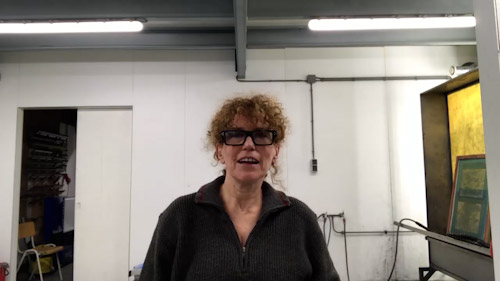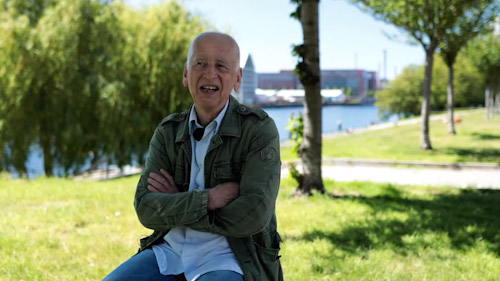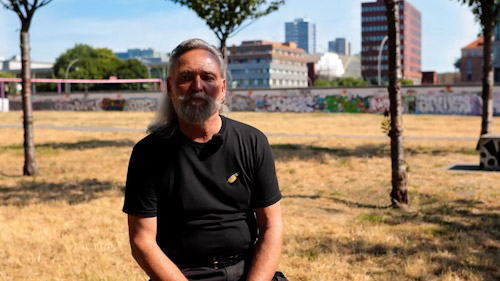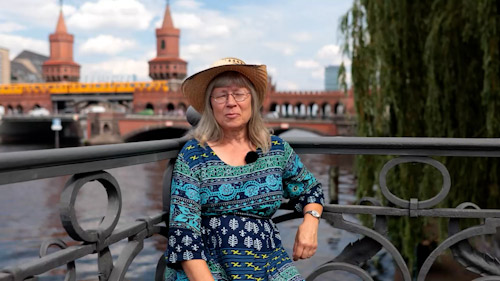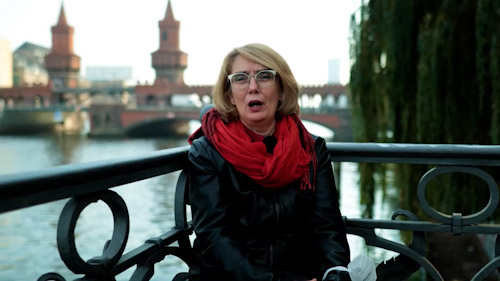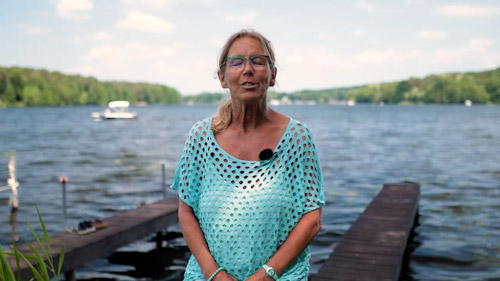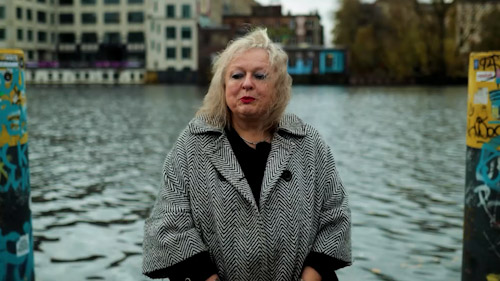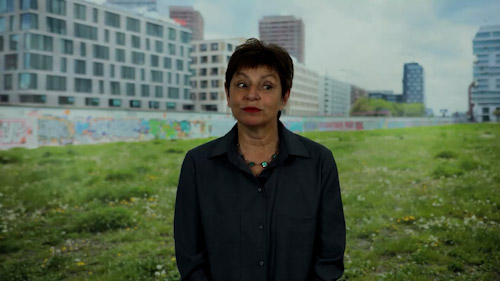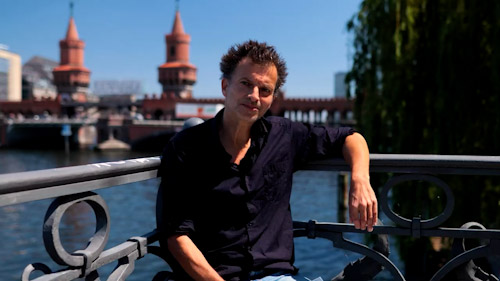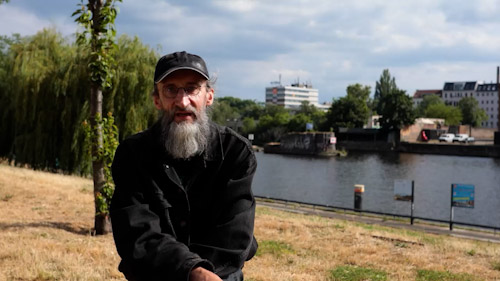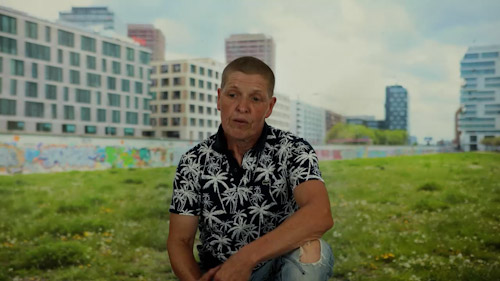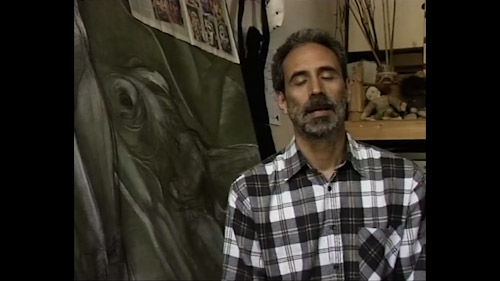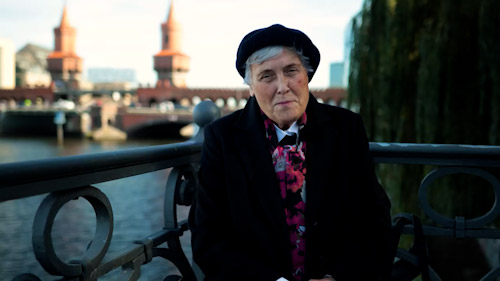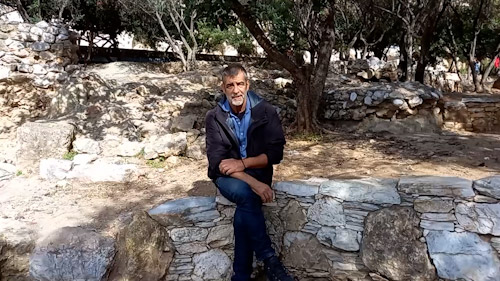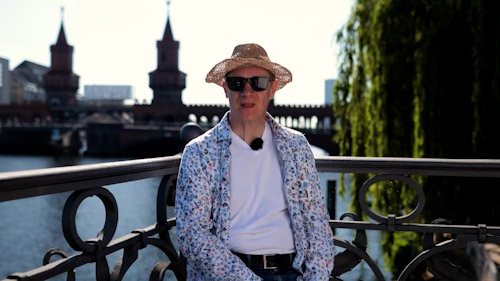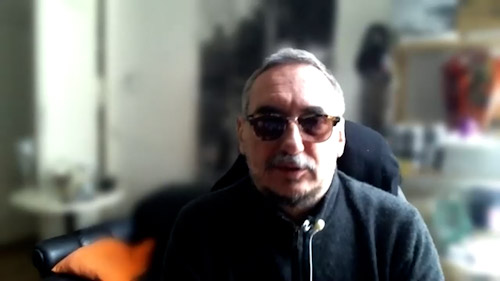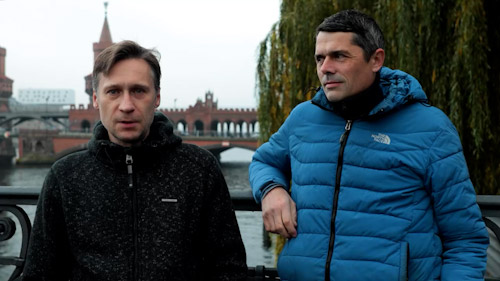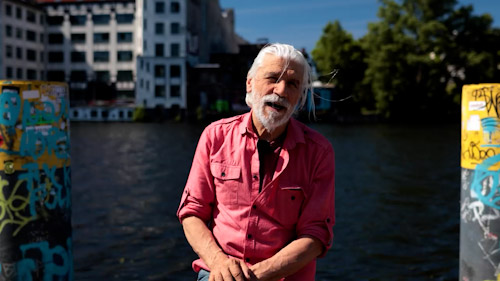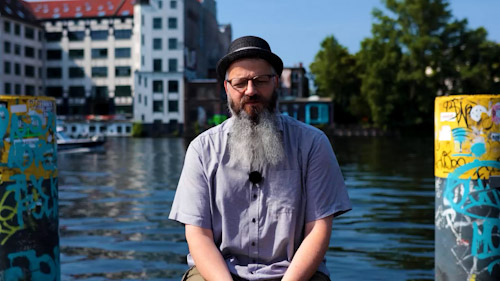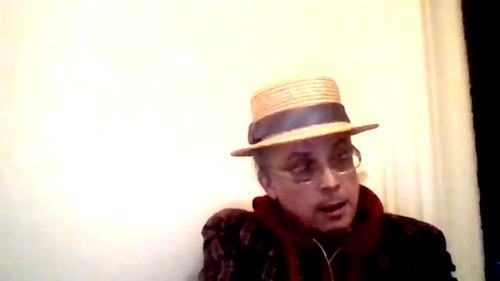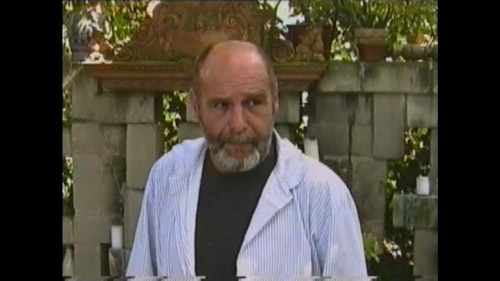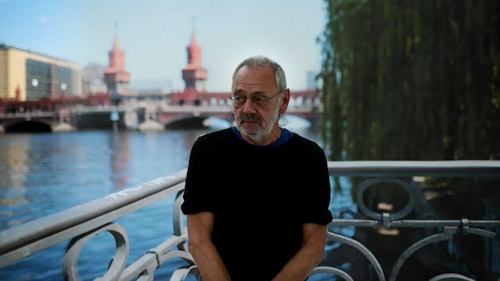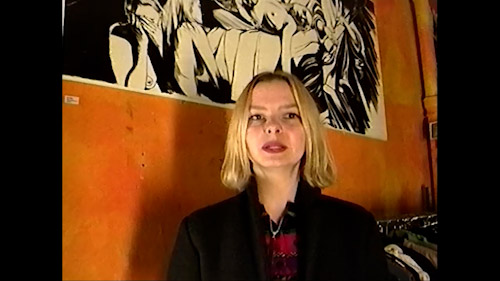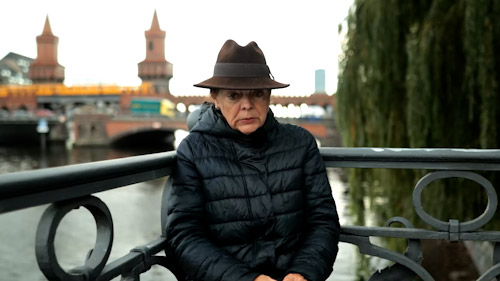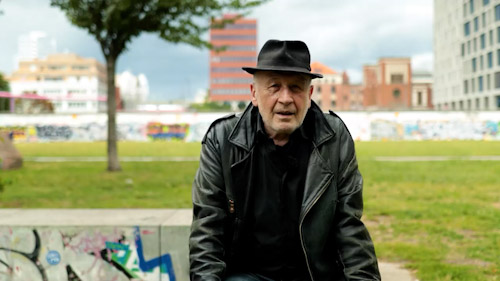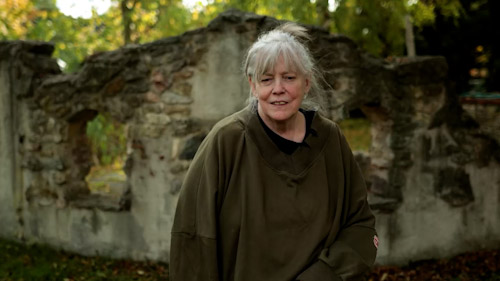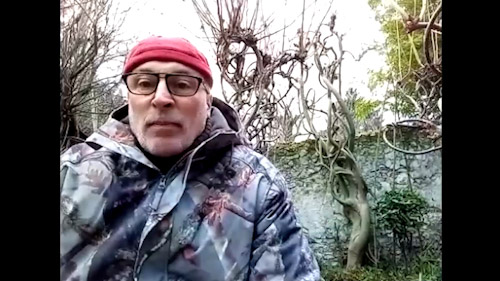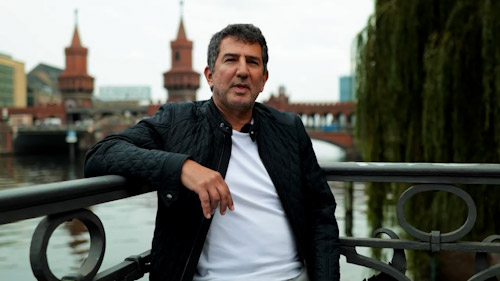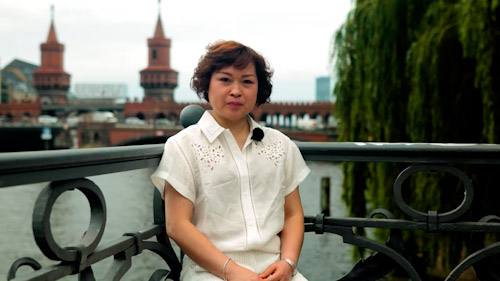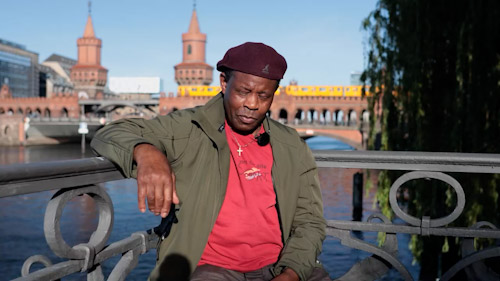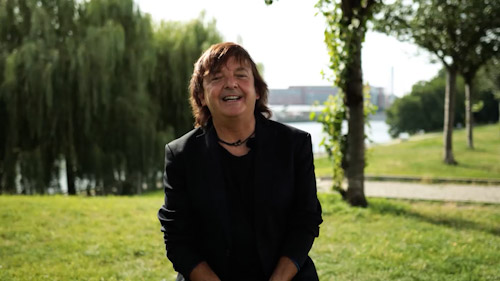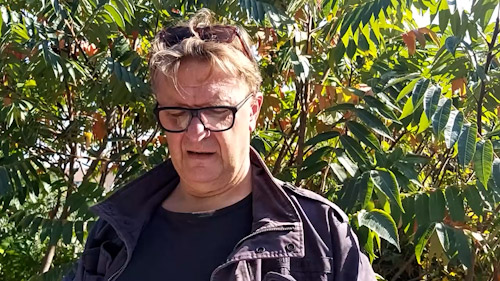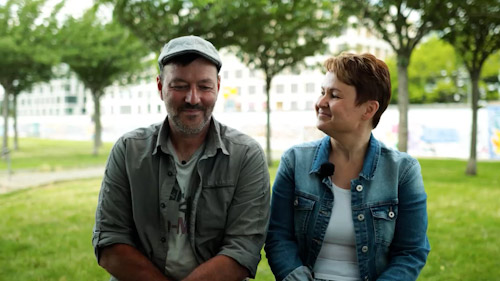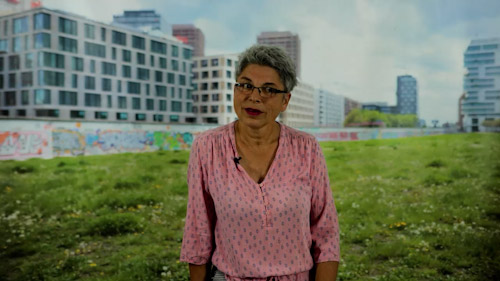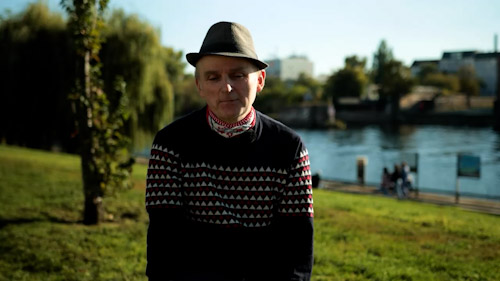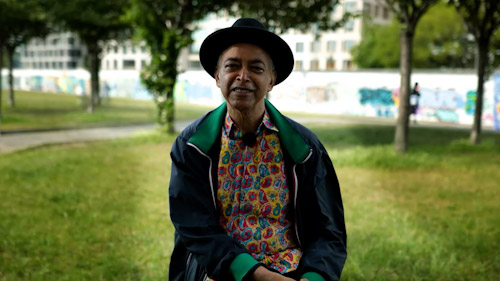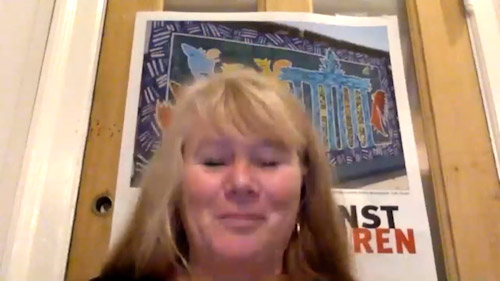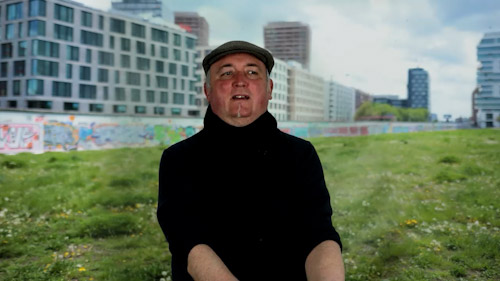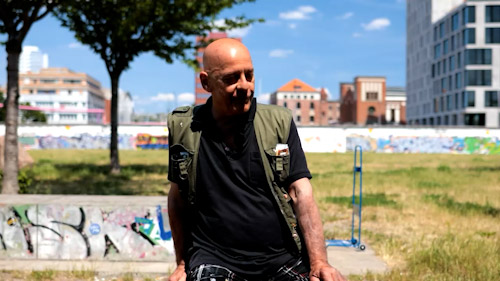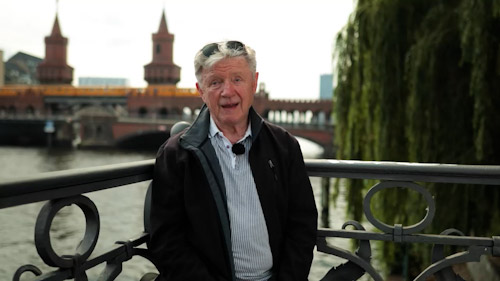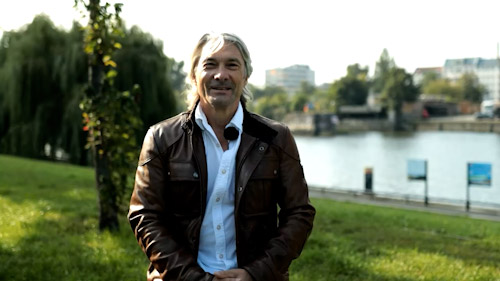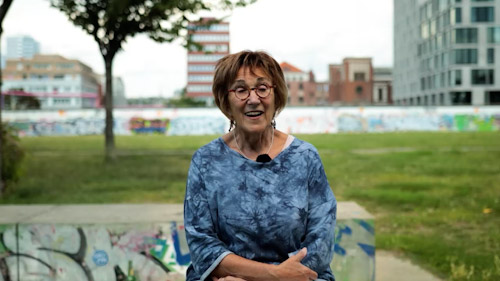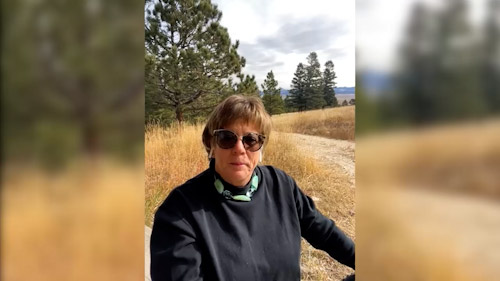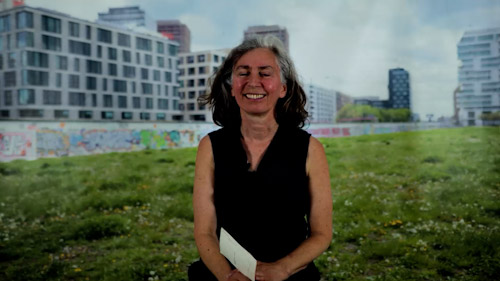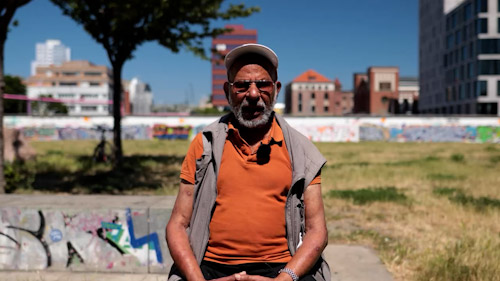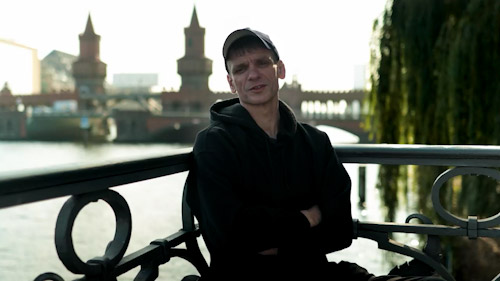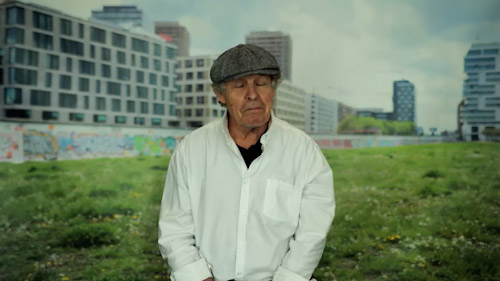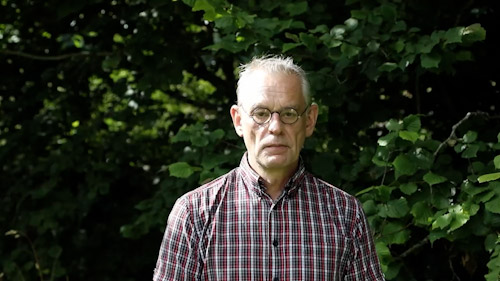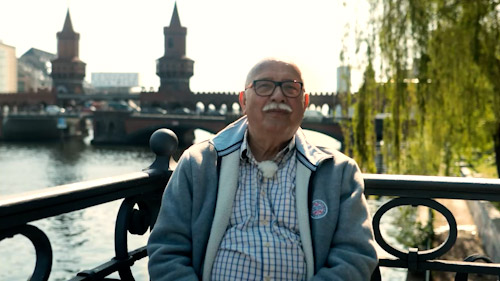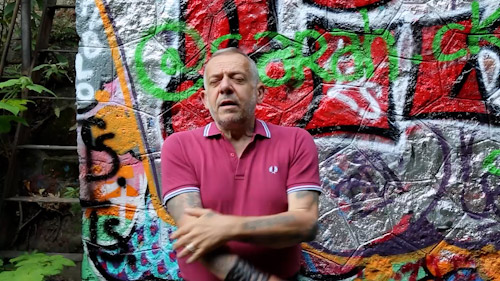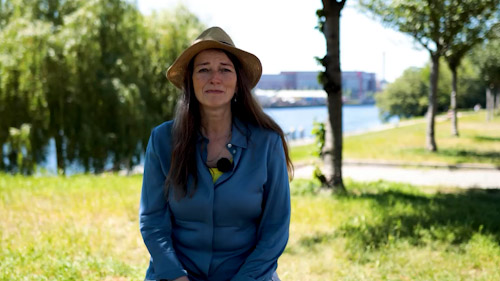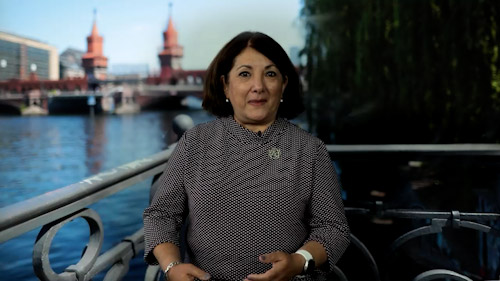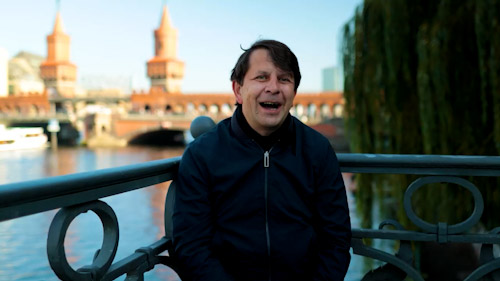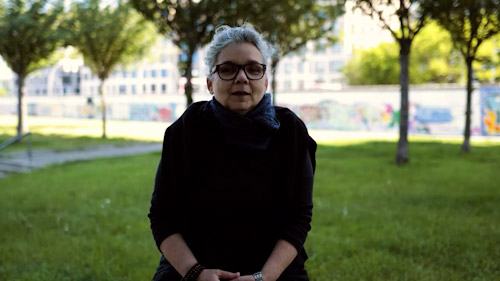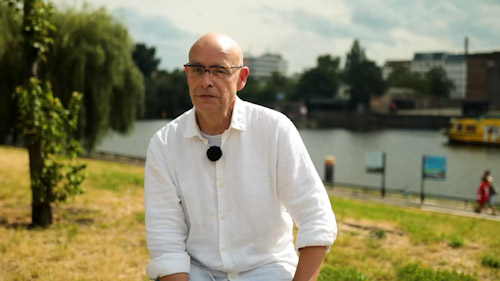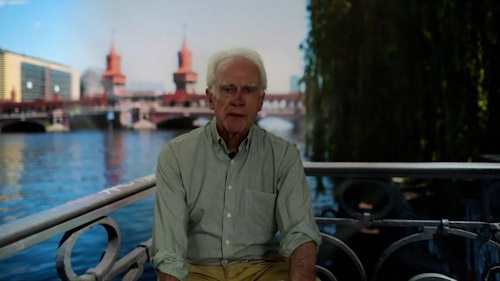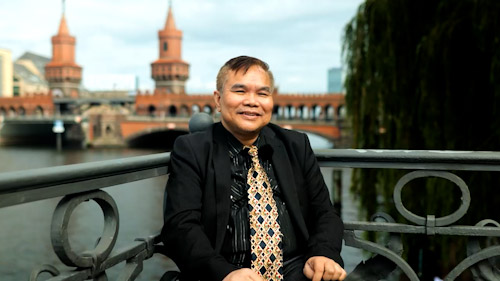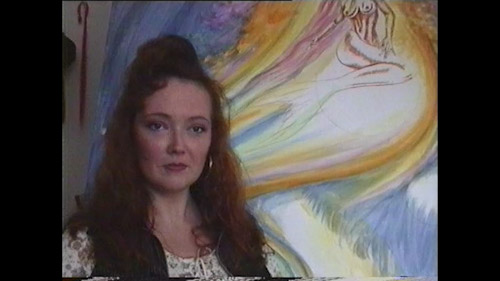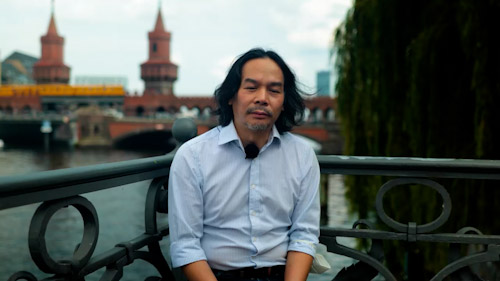Ana L. M. Rodrigues from Portugal lived in West Berlin from 1989 to 1992. Her painting in the East Side Gallery refers to the Chernobyl nuclear reactor disaster in 1986. It was her response to the organisers’ suggestion to address ecological issues.
Show list of videos ()
More about Ana L. M. Rodrigues: „Untitled“
The photographer Andreas Kämper attached a photo to the Wall in 1990. It showed a protester holding a GDR flag with the hammer and compasses cut out. In 2009, the image was reproduced by painting without his consent.
Show list of videos ()
More about Andreas Kämper: „Untitled“
Andy Weiss moved to West Berlin in 1986 and learned about the East Side Gallery from an announcement. His painting looks back at the two Germanies as well as ahead to the future. In 1996 he was co-founder of the East Side Gallery artists’ initiative.
Show list of videos ()
More about Andy Weiss: „Geist-Reise“
Bernadette Kern was actively involved in the church in East Germany. In autumn 1989 she took part in the Friedrichshain round table talks and is still politically active today.
Show list of videos ()
More about Bernadette Kern
Berrin Alpbek moved from Turkey to West Berlin to study in 1982. She recalls negative aspects of life after the border opened. Today she works in migrant support.
Show list of videos ()
More about Berrin Alpbek
Birgit Kinder painted the famous image of a "Trabi" car driving clean through the Wall. A resident of East Berlin since 1983, she painted her work spontaneously, without asking for permission. To her, it felt like living in paradise around the time the Wall came down.
Show list of videos ()
More about Birgit Kinder: „Test the Rest“
The opening of the border marked a new beginning to the East German artist Brigida Böttcher. Her 1990 painting "Flora geht" was an early reminder to take care of the enivronment and all life on the planet.
Show list of videos ()
More about Brigida Böttcher: „Flora geht“
C.F. from West Germany painted the feminist and anti-racist work “How’s God? She’s black” on the Berlin Wall. She painted it in response to an incident of verbal violence in April 1990 in Berlin.
Show list of videos ()
More about C. F.: „How’s God? She‘s black“
Carsten Joost is an architect und alternative city planner. He co-founded the Mediaspree versenken initiative to fight the privatisation of Spreeufer and retain public access to the riverbank at the East Side Gallery.
Show list of videos ()
More about Carsten Joost
Catrin Resch grew up in the GDR. Art was her hobby when she submitted her design for the East Side Gallery. Her Wall painting shows God protecting people from evil in the world.
Show list of videos ()
More about Catrin Resch: „Europas Frühling“
César Olhagaray came to the GDR after the 1974 putsch in Chile. His Wall painting shows the conflicting emotions surrounding the Peaceful Revolution and calls for confronting problems rather than ignoring them.
Show list of videos ()
More about César Olhagaray: „Uhrmenschen der Computer“
Christine Cyrus is a pastor’s wife and parish welfare worker. A resident of Friedrichshain for over fifty years, she lived through the Peaceful Revolution and the transition period in the district.
Show list of videos ()
More about Christine Cyrus
As a young man in the GDR, Dirk Moldt was involved in the oppositionist group Kirche von Unten and edited an SED-critical publication. He remembers the year 1989 as a liberating experience.
Show list of videos ()
More about Dr. Dirk Moldt
Erik Mahnkopf and Daniel Kensbock are graffiti artists from East and West Berlin, respectively. After the Wall came down, they seized on the many new opportunities and places to spray graffiti, including on the back of the Wall at Mühlenstraße, which became known as the "West Side Gallery".
Show list of videos ()
More about Erik Mahnkopf and Daniel Kensbock
Fulvio Pinna moved to West Berlin from Sardinia in 1987. With his painting "Hymne an die Freude" ("Hymn to Joy") he celebrated liberation from SED dictatorship. He painted it in a few hours straight on to the Berlin Wall, without referring to a sketch.
Show list of videos ()
More about Fulvio Pinna: „Hymne an die Freude“
Gábor Simon from East Berlin worked in the Narva lightbulb factory not far from the East Side Gallery. He was inspired to paint his abstract work by the music of the electro band Kraftwerk. He remembers being asked to paint an unpolitical work.
Show list of videos ()
More about Gábor Simon: „Space Magik“
Gabriel Heimler painted a work that shows borders being overcome. An artist with Hungarian and French nationality, the direction of crossing the border was not important to him, just the fact of doing it. He lives in New Zealand.
Show list of videos ()
More about Gabriel Heimler: „Mauerspringer“
Gerhard Lahr was born in 1938 and died in 2012. He was a well-known children’s book illustrator in the GDR. His Wall painting "BERLYN" portrays the first phase of building the Berlin Wall.
Show list of videos ()
More about Gerhard Lahr: „BERLYN“
Gerold Kohl moved to West Berlin when he was 29 and has lived in trailer camps in the city ever since. He remembers life in the East Side trailer camp and now campaigns for the protection of alternative living places.
Show list of videos ()
More about Gerold Kohl
Greta Ida Csatlò's painting depicts the opening of the border disrupted by the anti-hero "Sonic", who points to a future of war and destruction. The painting alludes to the ongoing struggle between good and evil.
Show list of videos ()
More about Greta Ida Csatlòs: „Sonic Malade“
Gudrun Prengel graduated in Social Studies and worked in various institutes of the GDR Academy of Sciences. From 1989 to 1994 she was actively involved in politics and society in the district of Friedrichshain.
Show list of videos ()
More about Dr. Gudrun Prengel
Günther Schaefer from West Germany was living in New York when he heard about the Wall coming down. He left for Berlin and documented the people and mood there in photographs. He has repainted his work "Vaterland" ("Fatherland") over 60 times.
Show list of videos ()
More about Günther Schaefer: „Vaterland“
Heike Püschel and Moritz Hillebrandt work for the US consortium Anschutz Entertainment Group Development GmbH, which bought the land around what is now Mercedes Platz.
Show list of videos ()
More about Heike Püschel and Moritz Hillebrandt
Heike Stephan came up with the idea for the East Side Gallery together with David Monty. An artist originally from Thuringia, she had painted on the Wall at Potsdamer Platz shortly after the border was opened.
Show list of videos ()
More about Heike Stephan
Hervé Morlay from France painted a cheerful street-art extravanganza on the Berlin Wall with Andreas Paulin from Germany. Leaving room for contributions from other artists, Morlay aimed with his painting to transform the Wall’s negative aura into a positive one.
Show list of videos ()
More about Hervé Morlay (VR) and Andreas Paulun: „Paix, Amour-Sagesse“
Heskel Nathaniel is managing director of Trockland Management GmbH, the company that built the mixed-use development "Pier 61 I 64" in the former border strip, comprising residential units, offices, and a hotel. Nathaniel sees the block as a testimony to a bygone era in urban planning.
Show list of videos ()
More about Heskel Nathaniel
Hiền Phan came to East Berlin in 1988 to be a "contract worker" and was employed in the VEB Narva lightbulb factory, not far from today’s East Side Gallery. Looking back, she remembers the time after German unification as generally positive.
Show list of videos ()
More about Hiền Phan
Ibraimo Alberto’s dream of studying sport led him from Mozambique to the GDR. Despite frequent racist attacks, he stayed in Germany and eventually turned his hobby into a profession after unification.
Show list of videos ()
More about Ibraimo Alberto
Catalonian artist Ignasi Blanch Gisbert still refers to his painting at the East Side Gallery in his work today. "Parlo d’amor" stands for the freedom to follow your heart and choose who to love.
Show list of videos ()
More about Ignasi Blanch Gisbert: „Parlo d‘amor“
Hungarian artist Imre Gábor painted a waterfall on the Berlin Wall. He was inspired by a poem on the 1948/49 Hungarian revolution in which water appears as a metaphor for uprising.
Show list of videos ()
More about Imre Gábor: „Wasserfall“
Jeanett Kipka’s Wall painting shows pieces of a whole that once fitted together but have come apart. An artist from East Berlin, she remembers the years after the Wall came down as a time of feeling you were not standing on solid ground.
Show list of videos ()
More about Jeanett Kipka: „Vogelflug“
Jim Avignon, one of Germany’s best-known pop artists, came to West Berlin in 1988. In 2009 he decided not to restore his Wall painting "Doin it cool for the East Side" but painted a completely new work in a flash-mob action in 2013.
Show list of videos ()
More about Jim Avignon: „Doin it cool for the East Side“
Jolly Kunjappu’s painting is titled “Dancing to Freedom” and appeals for freedom and peace. The artist was born in India and has lived in Germany since 1970. He is convinced that the human spirit cannot be suppressed by walls or war.
Show list of videos ()
More about Jolly Kunjappu: „Dancing To Freedom“
Administrative lawyer Jürgen Karwelat moved to West Berlin in the early 1980s. He joined the historical society Berliner Geschichtswerkstatt e.V. and campaigned to keep the Berlin Wall as a protected monument.
Show list of videos ()
More about Jürgen Karwelat
Danish artist Karina Bjerregaard came to Berlin right after reading about the East Side Gallery in a newspaper. Her painting "Himlen over Berlin" is inspired by a song by Nina Hagen and the Wim Wenders film "Der Himmel über Berlin" ("Wings of Desire").
Show list of videos ()
More about Karina Bjerregaard: „Himlen over Berlin“
Karsten Wenzel moved to East Berlin in 1988 and co-founded a cinema poster painting firm, Kinomalerei. His painting criticises the arrogance shown by rulers and the public alike. He remembers that in 1990 hardly anyone believed the East Side Gallery would stay standing.
Show list of videos ()
More about Karsten Wenzel: „Die Beständigkeit der Ignoranz“
Kiddy Citny from West Berlin painted on the Wall in Kreuzberg before 1989 – in a bid to reduce it to absurdity. His painting in the East Side Gallery criticises the way unification took place.
Show list of videos ()
More about Kiddy Citny: „qui baise qui“
Klaus Abraham, a fireman in West Berlin, carried out operations at various points along the Berlin Wall, including at Oberbaumbrücke. He was on the scene when 8-year-old Cengaver Katrancı fell in the Spree and drowned.
Show list of videos ()
More about Klaus Abraham
Lutz Pottien escaped from East Berlin to West Berlin by entering a marriage on paper. He spontaneously painted a work in the East Side Gallery and consciously chose unpolitical motifs that he personally liked.
Show list of videos ()
More about Lutz Pottien: „Pottiens persönliches Eigentum“
Manfred Kühne has worked in city planning and administration for many years. Director of the Berlin Monument Authority from 2001 to 2008, he describes the different attitudes and approaches to the East Side Gallery at the time.
Show list of videos ()
More about Manfred Kühne
Scottish artist Margaret Hunter painted the work "Joint Venture". It shows both the supposed ideal picture of unified Germany and the reality, with figures twisting and turning to adapt to their new situation.
Show list of videos ()
More about Margaret Hunter and Peter Russell: „Hands“
With her painting "Tolerance", US artist Mary Mackey criticised the mutual mistrust between the people of West and East Berlin. Accepting "the others" is still as important as it was over 30 years ago.
Show list of videos ()
More about Mary Mackey: „Tolerance“
Norbert Trompeteler was born in East Berlin in 1973. He remembers the period after the Wall came down as a time when the city was alive with music and parties, especially techno.
Show list of videos ()
More about Norbert Trompeteler
West German artist Peter Lorenz painted the fall of the Wall at the Brandenburg Gate in the East Side Gallery: chaotic scenes of societies and ideologies collapsing and being reborn.
Show list of videos ()
More about Peter Lorenz: „Untitled“
Rab Lewin was born in Scotland and moved to Berlin in 1992, living in squatted houses and trailer camps. He remembers the trailer camp at the East Side Gallery as a free zone without rules or organisation.
Show list of videos ()
More about Rab Lewin
Rainer Menzel was born in Dresden in 1945. As a political officer in the East Berlin border troops, he was responsible for political training. In November 1989, he was appointed press officer of the Mitte border command and supported the creation of the East Side Gallery.
Show list of videos ()
More about Rainer Menzel
Ralf Marsault spent periods in the 1990s living in the trailer camp at the East Side Gallery and later lived for fifteen years in the Kreuzdorf trailer camp. He produced photographic portraits of the residents.
Show list of videos ()
More about Ralf Marsault
Sabine Kunz from the GDR painted her sense of delight at the newly gained freedoms after the Wall came down in the East Side Gallery. But her work "Die Tanzenden" ("The Dancers") is also a warning against opportunism and manipulation.
Show list of videos ()
More about Sabine Kunz: „Die Tanzenden“
Sándor Györffy from Hungary painted on the West side of the Berlin Wall in Kreuzberg before 1989. His artwork at the East Side Gallery portrays the power of language to break down walls.
Show list of videos ()
More about Sándor Györffy: „Mauerdurchbruch“
Sanem Kleff arrived in West Berlin from Turkey as a young teacher. Looking back at the time around 1989/90, she remembers the hostility that then hit people from migrant backgrounds. Today she runs the anti-racism school network Schule ohne Rassismus – Schule mit Courage.
Show list of videos ()
More about Sanem Kleff
West Berliner Sebastian Eberhard started DJing in Berlin clubs in 1991. Known as Bass Dee, he gained legendary status as resident DJ in various clubs including Maria, Ostgut and Suicide.
Show list of videos ()
More about Sebastian Eberhard
Siegrid Müller-Holtz arrived in the GDR as a nine-year-old from West Germany. With her painting "Gemischte Gefühle" ("Mixed Feelings") she aimed to warn against imminent dangers threatening the world. It shows a black sphere crashing into a landscape and spreading out.
Show list of videos ()
More about Siegrid Müller-Holtz: „Gemischte Gefühle“
Cuban artist Teresa Casanueva moved to the GDR in 1985 to study art. In 1989 she decided to stay in Germany permanently. Her family still lives in Cuba under the Communist government.
Show list of videos ()
More about Teresa Casanueva: „Untitled“
Ursula Wünsch was a toy and game designer in the GDR. She painted a work for all the world’s children in the East Side Gallery. Today, she regards the East Side Gallery as not worth preserving.
Show list of videos ()
More about Ursula Wünsch: „Frieden für Alles“
Uwe Nübel was actively involved in parish life and the Christian Democratic Party in the GDR. In 1989 and 1990 he played an important role in local politics, especially in Friedrichshain.
Show list of videos ()
More about Uwe Nübel
Volker Hassemer was Senator for Urban Development and Environmental Protection in West Berlin. From 1990 to 1996 he worked towards a cross-Berlin policy on urban planning.
Show list of videos ()
More about Volker Hassemer
Vũ Ngọc Roãn came to Berlin in 1982 to be a "contract worker". As well as recalling the delight at being able to get to know "the West", he remembers the bureaucratic hurdles that made it difficult for him to stay in Germany after the Wall came down.
Show list of videos ()
More about Vũ Ngọc Roãn
Yvonne Onischke from West Berlin portrayed her fear of social divides, environmental disaster, and nuclear power on the Berlin Wall. But she also conveyed the possibility of finding solutions.
Show list of videos ()
More about Yvonne Onischke (Yoma): „Berlin bei Nacht“
Đào Quang Vinh was a "contract worker" in the GDR. He fought for his right to stay in Germany after German unification in 1989. Today he is site director of a language school.
Show list of videos ()
More about Đào Quang Vinh
